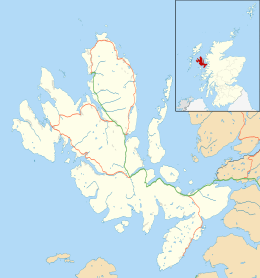Dunvegan Castle
Dunvegan Castle is located 1 mile (1.6 km) to the north of Dunvegan on the Isle of Skye, off the west coast of Scotland. It is the seat of the MacLeod of MacLeod, chief of the Clan MacLeod. Probably a fortified site from the earliest times, the castle was first built in the 13th century and developed piecemeal over the centuries. In the 19th century the whole castle was remodelled in a mock-medieval style. The castle is built on an elevated rock overlooking an inlet on the eastern shore of Loch Dunvegan, a sea loch.
Scottish Gaelic: Caisteal Dhùin Bheagain | |
 The south-west face of the castle | |
 Location of Dunvegan Castle | |
| Location | Scotland |
|---|---|
| Coordinates | 57.448°N 6.590°W |
| Altitude | 15 m (49 ft) |
| Type | Castle |
| Part of | Dunvegan |
| History | |
| Founded | 13th–19th century[1] |
| Associated with | Clan MacLeod |
| Site notes | |
| Condition | Occupied as a residence |
| Ownership | Hugh Magnus MacLeod of MacLeod |
| Public access | Historic Houses Association |
| Website | http://www.dunvegancastle.com/ |
| Architecture | |
| Architectural styles | Medieval architecture, and Victorian Architecture |
| Designation | Category A listed building |
History
The site is likely to have been a Norse dun (fort), though no traces of any prehistoric structure now remain. The promontory was enclosed by a curtain wall in the 13th century, and a four-storey tower house was built in the late 14th century. This tower was similar in style to contemporary structures at Kisimul Castle and Caisteal Maol.[1] Alasdair Crotach, the 8th chief, added the Fairy Tower as a separate building around 1500. During the 17th century, new ranges of buildings were put up between the old tower and the Fairy Tower, beginning in 1623 with the state apartment built by Ruaraidh Mor. The old tower was subsequently abandoned until the late 18th century, when the 23rd chief began the process of homogenising the appearance of the castle. This process continued under the 24th and 25th chiefs, with the addition of mock battlements and the new approach over a drawbridge from the east. The present appearance of the castle dates from around 1840 when this process of "baronialisation" was completed.[1] The castle is a Category A listed building.[2]
Site
Dunvegan Castle occupies the summit of a rock some 50 feet (15 m) above sea level, which projects on to the eastern shore of a north-facing inlet or bay. On the eastern, landward side of the site is a partly natural ditch around 18 feet (5.5 m) deep.[1]
Artifacts
Notable family heirlooms kept at Dunvegan Castle include:
Gallery
 Round Garden, Dunvegan Castle
Round Garden, Dunvegan Castle The Walled Garden, Dunvegan Castle
The Walled Garden, Dunvegan Castle Dunvegan Castle
Dunvegan Castle Panorama of Dunvegan Castle
Panorama of Dunvegan Castle Dunvegan Castle port
Dunvegan Castle port_(14762008186).jpg) Artist's impression of the castle c. 1500
Artist's impression of the castle c. 1500
References
- "Dunvegan Castle". CANMORE. Historic Environment Scotland. Retrieved 4 April 2017.
- "Dunvegan Castle, approach causeway and bridges. LB501". Historic Environment Scotland. Retrieved 4 April 2017.
External links
| Wikimedia Commons has media related to Dunvegan Castle. |